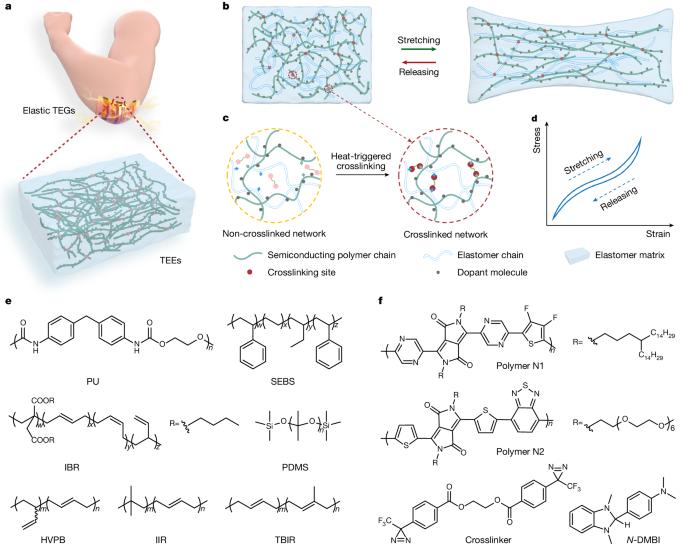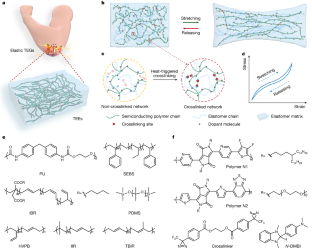n-Type thermoelectric elastomers
IF 48.5
1区 综合性期刊
Q1 MULTIDISCIPLINARY SCIENCES
引用次数: 0
Abstract
Intrinsically elastic thermoelectric generators with superior conformal coverage and shape adaptability are highly desirable for developing self-powered wearable electronics, soft bioelectronics and personal temperature regulators1,2. Until now, all reported high-performance thermoelectric materials have realized only flexibility, rather than elasticity3,4. Here we present one of the first n-type thermoelectric elastomers by integrating uniform bulk nanophase separation, thermally activated crosslinking and targeted doping into a single material. The thermoelectric elastomers could exhibit exceptional rubber-like recovery of up to 150% strains and high figure of merit values rivalling flexible inorganic materials even under mechanical deformations. Conventional wisdom suggests that incorporating insulating polymers should dilute the active component in organic thermoelectrics, resulting in lower performance. However, we demonstrate that carefully selected elastomers and dopants can promote the formation of uniformly distributed, elastomer-wrapped and heavily n-doped semiconducting polymer nanofibrils, leading to improved electrical conductivity and decreased thermal conductivity. These thermoelectric elastomers have the potential to make elastic thermoelectric generators in wearable applications much more conformable and efficient. A microphase crosslinking strategy, leveraging aziridine-based crosslinkers, is used to render organic thermoelectric materials stretchable and elastic.


n型热电弹性体
具有优异保形覆盖和形状适应性的固有弹性热电发电机是开发自供电可穿戴电子产品、软生物电子产品和个人温度调节器的理想选择1,2。到目前为止,所有报道的高性能热电材料都只实现了柔性,而不是弹性3,4。在这里,我们提出了第一个将均匀体纳米相分离,热激活交联和靶向掺杂集成到单一材料中的n型热电弹性体之一。热电弹性体可以表现出优异的橡胶样恢复,高达150%的应变,即使在机械变形下也能与柔性无机材料相媲美。传统观点认为,加入绝缘聚合物会稀释有机热电材料中的活性成分,导致性能降低。然而,我们证明了精心选择的弹性体和掺杂剂可以促进均匀分布,弹性体包裹和大量n掺杂的半导体聚合物纳米纤维的形成,从而提高导电性和降低导热性。这些热电弹性体有潜力使可穿戴应用中的弹性热电发电机更加舒适和高效。
本文章由计算机程序翻译,如有差异,请以英文原文为准。
求助全文
约1分钟内获得全文
求助全文
来源期刊

Nature
综合性期刊-综合性期刊
CiteScore
90.00
自引率
1.20%
发文量
3652
审稿时长
3 months
期刊介绍:
Nature is a prestigious international journal that publishes peer-reviewed research in various scientific and technological fields. The selection of articles is based on criteria such as originality, importance, interdisciplinary relevance, timeliness, accessibility, elegance, and surprising conclusions. In addition to showcasing significant scientific advances, Nature delivers rapid, authoritative, insightful news, and interpretation of current and upcoming trends impacting science, scientists, and the broader public. The journal serves a dual purpose: firstly, to promptly share noteworthy scientific advances and foster discussions among scientists, and secondly, to ensure the swift dissemination of scientific results globally, emphasizing their significance for knowledge, culture, and daily life.
 求助内容:
求助内容: 应助结果提醒方式:
应助结果提醒方式:


